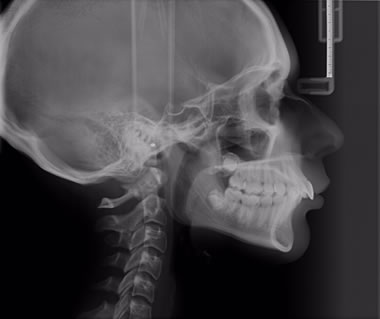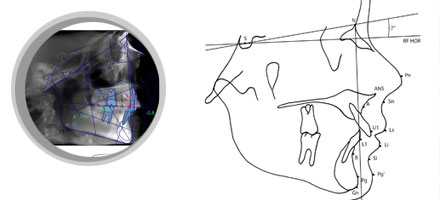OUR DIAGNOSTIC, ORTHODONTIC PROCEDURE
1. first detailed visit by the orthodontist first appointment at the dentist’s

2. second visit with material collection:
the impressions are taken for making models (cast copy of the dental arches)

radiographies, orthopantography and teleradiography (to check the relationship between the jawbones through a cephalometric test)


pictures (to analyze the aesthetical inference of the treatment)
3. discussion of the orthodontic treatment plan by the orthodontist

The orthodontic treatments:
Interceptive orthodontia

It is also called premature, orthopaedic and/or functional orthodontia and is used as a premature treatment of functional problems, which can be dental problems or problems related to the jawbone growth. It is usually used for growing children who have got a deciduous complement of teeth (milk teeth) or a mixed complement of teeth. Unlike the fixed orthodontia this orthodontia uses mostly removable braces and takes advantage of the muscular strengths to drive the jaw growth and allow the teeth repositioning.
Fixed buccal orthodontia

It is usually used for patients with a permanent complement of teeth. For these patients a fixed brace is the best solution. This kind of treatment uses mechanical forces (orthodontic flosses, springs and rubber bands) to allow the teeth repositioning.
The skeletal anchorage: the minisprings

They are temporary anchorage devices. These little titanium or steel springs are used in some clinical cases to achieve a dental movement more precisely and quicker. The possibility to anchor to the patient’s bone through very little miniplants, which are immediately removed after using, allows further orthodontic solutions. Dental movements, which until recently were considered impossible because of the lack of anchorage, today are possible just by using these devices.
Just a few minutes to insert them and a few seconds to remove them, no bother for the patient and absolute guaranty for the dentist: this makes this treatment a wonderful and sometimes even unique solution.
Lingual orthodontia

The lingual orthodontia is the dental technique which allows to apply the brace attachments onto the inner part (or lingual part) of the tooth, thus making it invisible from the outside.
The “Invisalign®” technique
It allows to make orthodontic treatments without using the traditional metal devices. It uses instead little transparent masks, which are very easy to wear and contain the movement to be transferred to the teeth.
They are hygienic and follow a “mathematic” treatment plan, which the patient can know before undergoing the treatment.
The orthodontic treatment with Invisalign® consists of a range of removable and nearly invisible alignment devices, which are replaced with new ones every two weeks. Each alignment device is specifically made for a specific patient’s teeth. When the alignment devices are replaced the teeth gradually move, week after week, until they align into the final position decided by the orthodontist.
Moreover a virtual 3D treatment programme (ClinCheck® software) shows the movement which the teeth make during the treatment. So the patient knows in advance what the teeth look like at the end of the treatment. The results of the ClinCheck system allow to make custom-made transparent alignment devices.


